 Loading... Please wait...
Loading... Please wait...- 727-541-5900
- My Account
Currency Displayed in
- Home
- Resource Center
- AED FAQ
AED FAQ
AED FAQ
Frequently Asked Questions
- If your AED is emitting a series of triple chirps, what should you do?
- When an AED says "analysis interrupted" during use, what does this mean?
- American Heart just issued new guidelines for CPR. What does that mean
- When do you have to replace the AED pads?
- How often do you need CPR/AED training for your office or team?
- How often should you change your AED battery?
- Can I use an AED on someone who has wet skin or is sweating?
- How often should you check your AED?
- If your AED is chirping or beeping, what should you do?
- If you put the AED pads on a patient’s chest and it says “No Shock Advised,” what does that mean?
If your AED is emitting a series of triple chirps, what should you do?
If your AED emits a series of triple chirps (♪♪♪...♪♪♪...♪♪♪...), this could mean that a potentially serious problem was detected during self-test that could prevent your AED from delivering therapy in an emergency.
If you ever hear your AED emit a series of triple chirps:
- During Standby mode: Please call Altra Medical / Philips immediately for technical support.
- During an Emergency Rescue: Press the flashing blue i-button and follow the voice prompts. Removing and reinserting the battery can clear some errors, and equip the device to deliver therapy in a rescue. The battery removal and reinsertion procedure should only be done in an emergency situation. Once the emergency is over, call Altra Medical / Philips immediately.
- WARNING: Removing and reinserting the battery one or more times when an AED emits a series of triple chirps may reset the device and cause it to report it is ready for use, though it may be unable to deliver therapy during a rescue. Removing and reinserting hte battery when your AED is emitting a pattern of triple chirps should only be done during and emergency. If your device is emitting a series of triple chirps in standby mode, or after an emergency, please remove the AED from service and contact Altra Medical / Philips immediately.
In the rare event that an AED fails during use and is unable to deliver shock therapy, you should:
- Ensure that 911 has been called.
- Continue CPR while waiting for Emergency Medical Services to arrive.
- If an additional bystander is available, send him/her to locate another nearby AED.
For more information on triple chirps, check out www.philips.com/aedaudiblechirps.
If your AED is emitting single chirps or beeps, what should you do?
AED Question of the Month: December
When an AED says "analysis interrupted" during use, what does this mean?
a) Take the pads off the patient and replace them with new pads
b) AED has detected artifact from movement
c) AED machine timed out and needs to be restarted
d) Patient handling that is interfering with AED's ability to analyze patient's ECG
e) Answers B & D are correct
f) All of the above
Answers B & D are both correct. When your AED tells you "analysis interrupted" there are only two reasons why. One is that the machine has detected an artifact from movement. This means that the AED can not get a successful read because of movement other than that of the patient has been detected by the pads. Another reason why the AED may inform you that "analysis interupted" would be because of patient handling. If there is interference from the resonder during the patient handling this could affect how the AED reads the patient's ECG. If there is interfence the ECG read will not be able to be performed therefore the AED will inform of "analysis interupted",
AED Question of the Month: November
American Heart just issued new guidelines for CPR. Which are correct?
a) Compressions should be issued at a rate of 100-120 per minute.
b) Never do compressions during SCA
c) Provide compressions and breaths during CPR at a rate of 30:2
d) Compressions should be 3 inches deep for an adult
e) Answers A & C are correct
f) All of the above
The answer is E, both A & C are correct. The American Heart Association just released the G2015 Guideline updates for CPR and resuscitation. This year the AHA's guideline updates increased the rate to do CPR compressions for lay responders to 100-120 per minute. If a trained responder is at the scene of an emergency involving sudden cardiac arrest (SCA) they should issue compressions and breaths. The rate at which trained responders should issue compressions and breaths is 30:2.
You can also still do compressions only if you are concerned about putting your mouth on the victim. The depth of the compressions for adults should be just a little over 2 inches deep.
The good news is that the minor changes in the guidelines means that you won't need to make any changes to your AEDs. We will be sending out a complete description of the guideline changes shortly.
AED Question of the Month: October
When do you have to replace the AED pads?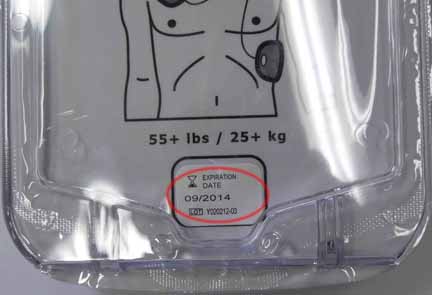
a) Once a year b) Every time you use them c) When the AED chirps d) When they reach their expiration date e) Only if they are used f) Never
The answers are B, D and sometimes C. The pads have an electrolytic gel on them so they will dry out over time. Philips pads and most other brands need to be replaced about every two years. Some such as a Zoll Z pad, and HeartSine have a four to five year life.
It is important to replace them when they reach their expiration date to be sure they will work effectively in that important moment in the middle of a rescue. The AED needs to see a good clear ECG signal, not a lot of artifact from dried out pads.
The pads must also be replaced everytime they are used, they cannot be reused.
 The Philips OnSite AED, FRx and FR3 AEDs will also daily check the gel moisture content of the pads - so if they are drying out the AED will chirp. If the AED chirps - push the blue information button and it will tell you if the pads need to be replaced or if it is the battery or some other problem..
The Philips OnSite AED, FRx and FR3 AEDs will also daily check the gel moisture content of the pads - so if they are drying out the AED will chirp. If the AED chirps - push the blue information button and it will tell you if the pads need to be replaced or if it is the battery or some other problem..
AED Question of the Month: September
How often do you need CPR/AED training for your office or team?
a) Once a year
b) Run an emergency simulation once every six months
c) Train all new staff members upon hiring
d) Discuss emergency plans at staff meeting
e) Renew American Heart Association certification every two years
f) We don’t need to train our employees
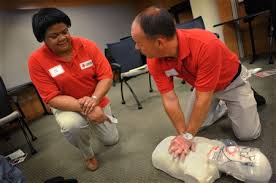
The answer is… E – Training should be done every two years minimum to comply with American Heart, Red Cross and most training organizations. A through D are considered best practices worth including in your work environment or community. While training is not required to use an AED, it’s highly recommended that at least a quarter of the employees receive CPR/AED training in an organization. Through training, employees can gain the confidence that makes a rescue more likely.
You can sign your team up to take American Heart’s HeartSaver CPR/AED classes so you can have a group that’s prepared to handle any sudden cardiac arrest event. Altra Medical can help arrange a training session for your team that will teach them how to use an AED and how to properly perform CPR on adults, (and children and infants), and each class can be tailored to your group. This certification lasts for two years and should be renewed upon expiration. Other best practices for emergency preparedness include offering CPR/AED training for any new hires, and being sure to provide information on the location of your office’s AED. It’s just as important to hold a regular discussion with all your employees regarding what to do in an emergency; this type of planning helps to keep safety at the top of your team’s mind. Another great way to ensure your organization is ready for an emergency is by running an emergency simulation at least once every six months. This could include a person simulating cardiac arrest or choking – or any scenario that requires immediate action. You’ll see how valuable these practice simulations can be if you’re ever faced with the real thing.
AED Question of the Month: August
How often should you change your AED battery?
a) Every time you use it
b) When the AED chirps
c) When it reaches the expiration date on the battery
d) Every four years on standby, if put in by the "install by" date
e) Every year, then I have to recharge it.
The answer depends on your brand of AED. Most of our customers have Philips AEDs -- in which case the answer is D -- normally every four years from the date that you install it. And if you have a spare battery in plastic, it is warranted for four years of use if installed before the "Install by" date.
Philips defibrillator batteries will give up to 200 shocks, so you won't need to replace it after each use. If you have a Physio Control CR+ or a Samaritan AED, you will need to replace the battery with each use.
If your AED is chirping, you should determine the reason. It could be a low battery -- or it could be pads are not useable or the AED has failed a self test. For Philips FRx and OnSite AEDs -- ALWAYS push the blue i button, and the device will tell you what the problem is. For other models, we can help you troubleshoot.
The specific replacement frequency varies between different brands and devices. Take a look at the chart below and see what applies to you and your device. If you’re unclear about when to replace your battery, give us a call, and we can help you.
| Brand (Model) | Photo | Frequency |
| Philips (OnSite M5066A & FRx 386104) |  |
|
| Philips (FR2 M3861A or M3860A) | 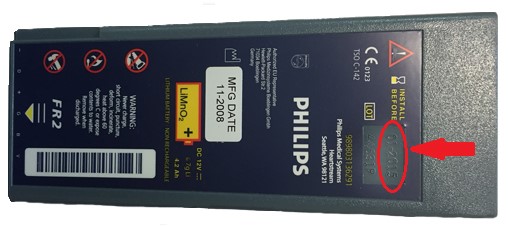 |
|
| Philips (FR3) |  |
|
| Philips (Forerunner) |  |
|
| Physio Control (Lifepak 500) |  |
|
| Physio Control (Lifepak 1000) |  |
|
| Physio Control (CR+) |  |
|
| Cardiac Science (G3) | 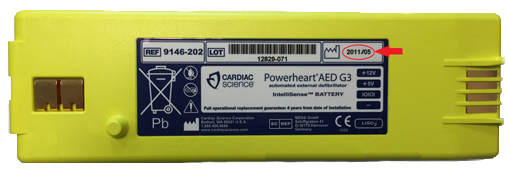 |
|
| Zoll (AED Plus) | 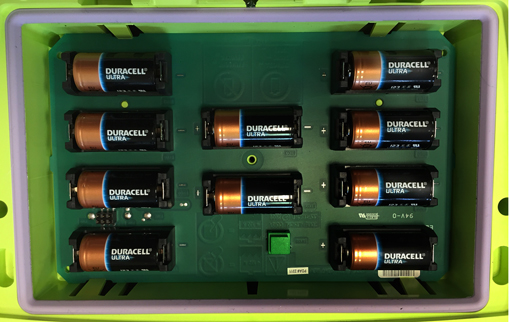 |
|
| Defibtech (Reviver DDU-100) |
|
|
| Defibtech (Reviver View DDU-2300) |  |
|
| HeartSine (Samaritan) | 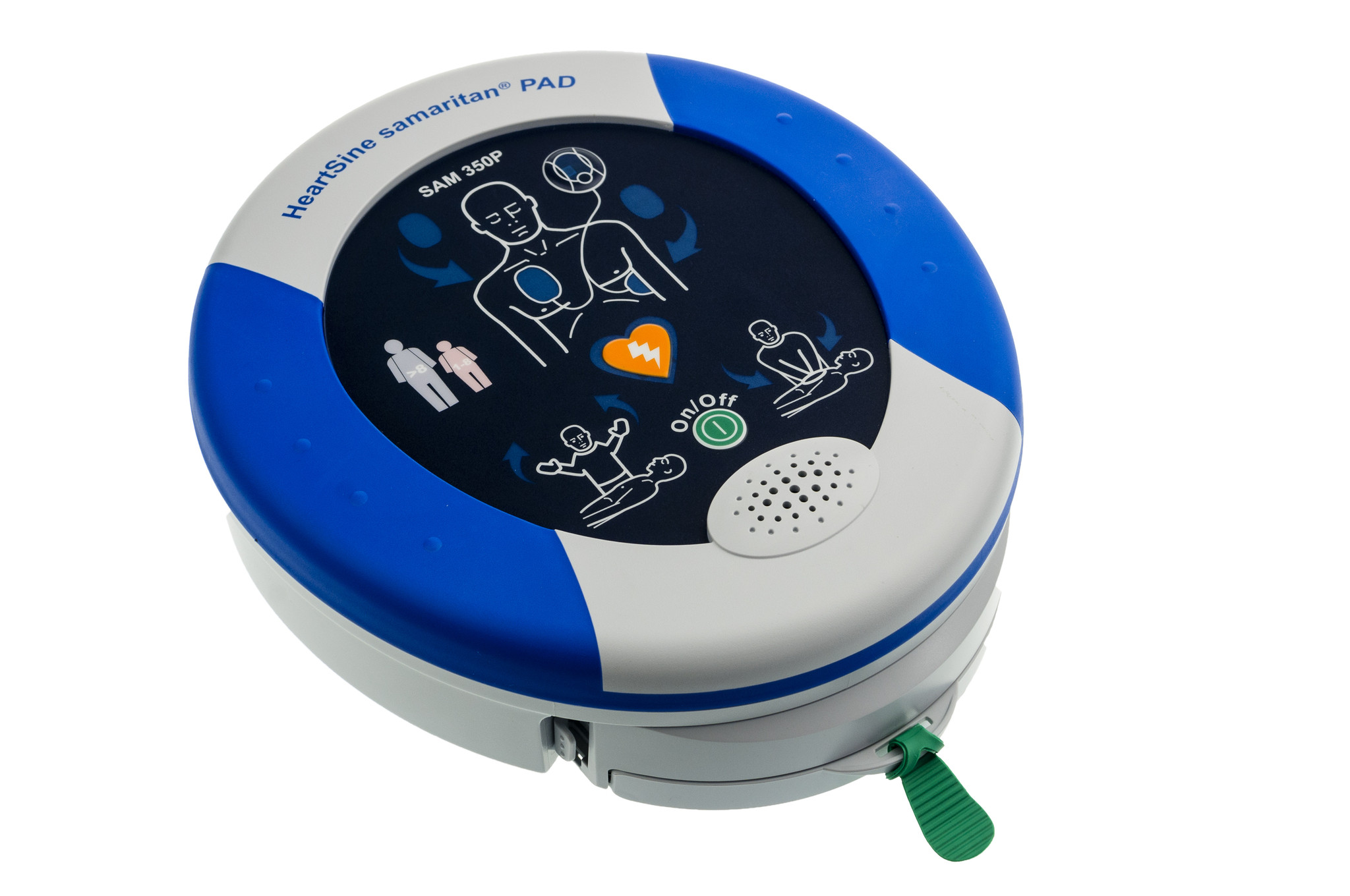 |
|
Managing your AED’s battery is an important task – failing to do so could mean the difference between life and death. That’s why it’s so important to pay attention to when you installed your battery and how much life it has left. It's helpful to write the date of installation on the battery so you can easily keep track.
Wondering what to do with that old battery? Consider recycling it at a local Batteries Plus or using a similar service.
Still have questions about battery use and maintenance? Call us: 727-541-5900.
AED Question of the Month: July
Can I use an AED on someone who has wet skin or is sweating?
A) Yes, remove any clothing and put the pads on the chest immediately
B) Yes, if you dry the chest with a shirt or towel
C) You must move the person to a dry area and completely dry them off.
D) No, don’t use the AED
Answer: B. It is very possible for someone to experience sudden cardiac arrest while swimming or using a hot tub, and it’s also very likely for a person experiencing SCA to be sweating profusely. This doesn’t mean you can’t use an AED on this person, it’s just important to remove any wet clothing on the chest and get the chest dry enough so that the pads adhere tightly to the skin. Because water is such an excellent conductor of electricity, it’s extra important to ensure the chest is as dry as possible so that the shock penetrates the skin through the heart to the other pad, rather than moving superficially across the chest through the water.
tub, and it’s also very likely for a person experiencing SCA to be sweating profusely. This doesn’t mean you can’t use an AED on this person, it’s just important to remove any wet clothing on the chest and get the chest dry enough so that the pads adhere tightly to the skin. Because water is such an excellent conductor of electricity, it’s extra important to ensure the chest is as dry as possible so that the shock penetrates the skin through the heart to the other pad, rather than moving superficially across the chest through the water.
One issue that many people face is ensuring a patient’s modesty when removing bathing suits. Removing clothing –particularly wet or damp clothing – is so important to the success of the rescue. Be sure to ask all unnecessary bystanders to leave the scene or have someone hold towels up – which is both important for safety and for modesty.

Please note Philips AEDs are safe to use on wet surfaces, you do not need to movem someone from a wet pool deck or wet grass. However some other brands do specify that they should not be used on wet surfaces, so check your manual.
However, it’s extremely important not to waste time waiting for the chest to dry. Starting the AED on the patient and performing CPR will help keep the patient alive until emergency responders arrive on the scene.
What would you do if your child was pulled from the water not breathing? Click here to learn when to perform CPR.
AED Question of the Month: June
How often should you check your AED?
a) When I remember
b) Each month
c) Each year
d) Daily
e) All of the above
The answer to this question is... unique to your situation. All AED owners or managers should be checking in on their AEDs on a regular basis, just to be sure the green status light is visible, and that the batteries and pads aren’t coming up on expiration.

If you keep your AED in your vehicle or next to your desk, then you’ll always be aware of the device if it chirps or requires attention. In these cases, it’s helpful to do a thorough monthly check, and because it’s easily accessible, it requires more passive attention. If the AED is in a place where it’s not immediately visible or audible, then be sure that someone is tasked to check that it’s not beeping or chirping on a daily basis.
Are you keeping your AED baseball field or at a park? Be sure that someone is tasked to check it each time they’re in there. This effort may require getting several people involved in the maintenance of your AED.No matter where you keep your AED, remember to do monthly checks for:
- A working status indicator
- Pads are not opened or expired
- The date on the battery is not near
- Connections are in good condition
- Accessories like scissors, razor, gloves, pocket mask and wipes are present
If you have any questions about your AED, we’re here to help. Just call us at 727-541-5900.
AED Question of the Month: May
If your AED is chirping or beeping, what should you do?
a) Stuff it in the closet.
b) Pull out the battery.

c) Press the blue button.
d) Do a battery insertion test
The correct answers are C and sometime D. If your AED has been making beeping or chirping noises (and you have a Philips OnSite or FRx AED), just press the blue information button, and you'll be able to diagnose the problem. It will come back and say pads not useable, low battery or remove and reinsert to test.
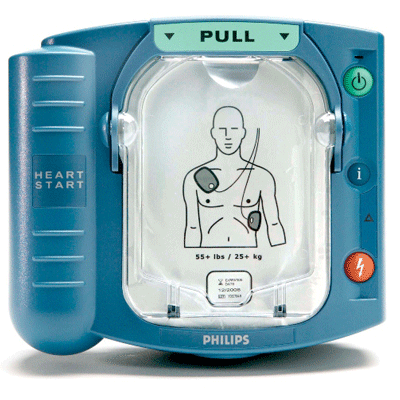 The AED tests the gel moisture content on the pads daily, and over time they can dry out. If someone has peeled back the pads it will cause the pads to dry out before their expiration date. Be sure no one gets curious and opens the pads.
The AED tests the gel moisture content on the pads daily, and over time they can dry out. If someone has peeled back the pads it will cause the pads to dry out before their expiration date. Be sure no one gets curious and opens the pads.
Low battery is self explanatory. Batteries for the OnSite and FRx are good for four years. Altra Medical carries a complete line of replacement batteries for when you need them.
If the AED says to remove and reinsert battery, then remove the battery and reinsert it. Push the buttons as required. If it still chirps, call Altra Medical 727-541-5900 and we can walk you through further diagnostics, or call Philips Customer Service at 1-800-263-3342 ext 1.
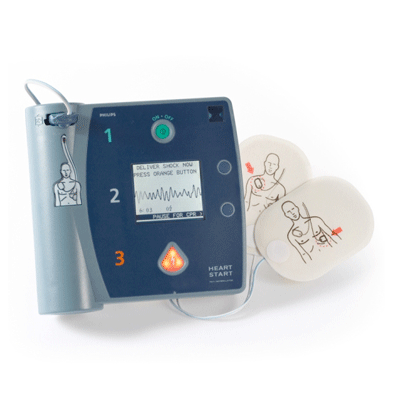
If you have a Philips FR2 and the AED is chirping, it will have a red X in the upper right hand corner. Remove the battery from the AED and reinsert it. It will go through a self test. If the battery is low, it will come back and say "Low Battery" on the screen. FR2 batteries are good for four years. Please call us or order a new one online if you would like to get a new battery.
Don't lock it in the closet. You want to be sure the AED is ready for use in that critical time when someone goes into cardiac arrest. It is telling you that it's time to replace your battery or pads! You can get those right on this site.
AFTER you determine what the problem is, remove the battery and replace the pads or battery, and allow it to go through a battery insertion test. If you don't have new pads or a spare battery, leave the battery out until you get those replacement supplies --that way you don't have to listen to it chirp. And, if needed, you may be able to deliver a shock or two.
In other news... Tampa Police Department Receives 100 AEDs for Patrol Cars
Question of the Month: April
If you put the AED pads on a patient’s chest and it says “No Shock Advised,” what does that mean?
a) The Patient has a weak heart beat
b) The Patient has been down a long time and needs CPR
c) The AED is not working correctly
The correct answers are A & B. When you put pads on a patient it will analyse the patient's heart rhythm to determine if a shock is needed. The AED will ONLY charge to shock if it sees a "shockable" rhythm - typically ventricular fibrillation or an unstable - polymorphic tachycardia.

So if a person has a weak heart that is still normal, it will say no shock advised. Also if a person has been down a long time and there is no activity in the heart to shock, it will say no shock advised. If the person is moving or breathing they will not need CPR. If the person is blue and the AED says no shock advised then likely they have been down for some time and very definitely need CPR.
As long as the AED says it is analysing the heart rhythm, it should be analysing the heart and make the correct determination. Just remember not all heart rhythms are shockable.
Check out Crunch Fitness - Saved the Life of a New Member!

